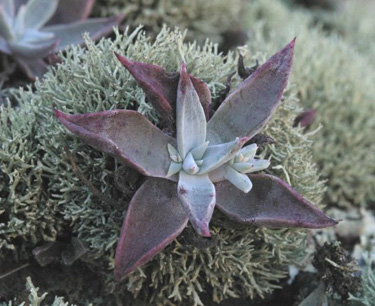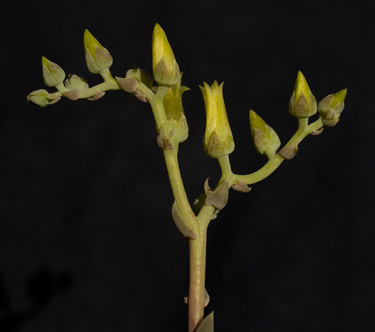The May 2013 Camarillo Springs Fire in Ventura County burned the entire habitat of a federally listed threatened plant species, a succulent known as Verity's liveforever (Dudleya verityi). Stephen McCabe, research director at the UC Santa Cruz Arboretum, has been working with National Park Service ecologist John Tiszler to study the plants and their potential for recovery in the aftermath of the fire.
In some areas where the succulents once grew, the fire was so hot that no plants could be found, according to McCabe and Tiszler. At other sites, the percentage of plants that appears to have survived is very small. In one area where 1,500 plants were counted in 2009, only 10 appeared un-scorched.
Because these plants can appear alive for awhile after their roots have been killed, researchers are hesitant to conclusively assess all the damage until after the first heavy fall rains. The fire occurred during the flowering period for these plants, but very few flowers have been seen since the fire on any of the Verity's liveforevers, so there might have been very little seed set this year.
While experts prefer to see a threatened species survive on its own, in this case the Verity's liveforever may need some help. Seed collected from garden-grown plants at the UCSC Arboretum could potentially be used to help restore the wild populations. No decisions have been made yet, however, about the best ways to facilitate the recovery.
Verity’s liveforever is only known from six reported occurrences in the western Santa Monica Mountains. It is listed by the U.S. Fish and Wildlife Service as threatened under the Endangered Species Act, in part due to the potential loss to quarrying, housing development, fire, and collecting. Air pollution, non-native weeds, and trampling of habitat during recreational use may also be threats.
There is often debate about whether or not chance events could really have an effect on an endangered species that has more than one occurrence. Unfortunately, this is a case where a single event has adversely affected an entire species, McCabe said.
The Springs fire started along Highway 101 and within several hours had burned the entire 5,000-acre area over which the Dudleya populations are dispersed. The fire ultimately burned 24,000 acres over three days. Like almost all fires in the Santa Monica Mountains, it was a manmade fire, started by an automobile. Its occurrence during the spring growth and flowering period, rather than the late summer dormancy period, was unusual.
Unfortunately, some climate-change models predict that conditions for such early fires will become more common. At the same time, increasing human populations make additional fire starts inevitable. The proximity to urbanization of all six occurrences of Verity's liveforever makes it likely that there will be damaging fires in the future.
Fire experts and public agencies remind the public to be especially careful not to start fires in a dry year like this one. They also emphasize the need for interagency cooperation to protect and restore endangered species that grow on a mix of different public and private lands.
The Arboretum maintains back-up collections for many species from around the world for events just such as this and encourages people to help the wild populations survive.
The UCSC Arboretum relies on gifts, memberships, and gift shop sales to pay for salaries, plants, supplies, and technology. The Arboretum is open every day from 9 a.m. to 5 p.m. More information is available online at arboretum.ucsc.edu.




